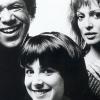The Reader
Must-Read TV
After a quarter-century of living here in Coolsville, very little about my hipster brethren and sistren surprises me anymore, except for one thing. I’m amazed at how few people I meet admit to watching television. Personally, I don’t believe it—nobody actually spends the endless hours listening to and dissecting the music of Serge Gainsbourg or Magnetic Fields, or exclusively watching the experimental foreign-language cinemah that these people claim to do without some sort of respite. Nobody can possibly be that arch. Even if you watch it ironically, you still watch TV.
The fact is that there is nothing wrong with watching television. Sure, it’s a lowest-common-denominator pastime, but that also means that it’s the only activity that comes anywhere close to a nationally shared experience. It’s the only activity that 300 million people can do at the same time. You want to live like common people; you want to do what common people do? Then you watch the TV people cavort for your pleasure or present the day’s events in stentorian tones, and you do so without shame.
Because TV is ubiquitous, both as an entertainment medium and as a primary source of information, the study of television is a legitimate subject for historians and sociologists. What we watch reflects who we are and helps to shape what we think—people who heard the famous 1960 Kennedy-Nixon debate on the radio thought Nixon had won—and at no time is that more evident than when we look at TV at its most-watched.
For the bulk of the 1980s and ‘90s, there was no more powerful regular event in America than the Thursday night prime-time lineup on NBC, what would become known as “Must-See TV.” At its peak, that single night of programming generated more advertising revenue than an entire week on the rest of the broadcast networks. Combined. The shows that ran on Thursday nights during that time period were the definition of water-cooler shows, dominating the national conversation on Friday mornings, and while many of us could not have cared less about Sam and Diane, Ross and Rachel or Will and Grace, we knew what everyone else was talking about. And though "Seinfeld" has now been off the air for five more years than it was on, we still quote it relentlessly, and several of its phrases have entered the lexicon.

The guiding hand at NBC during those years was Warren Littlefield, who served as director of comedy programming and then president of entertainment for the network, an exalted and precarious position in the cutthroat business of amusing America. During his tenure, Littlefield shepherded the development of "Cheers," "The Cosby Show," "Seinfeld," "Friends," "Frasier," "ER," "Mad About You," "Will & Grace," "Law & Order" and a number of other programs that continue to generate millions in syndication. His new book, Top of the Rock: Inside the Rise and Fall of Must See TV (with T.R. Pearson, Random House, 2012) is a chronicle of those years and a surprisingly fascinating read.
Although he was one of the suits, Littlefield’s secret as a developer of TV programs was to assemble talent and allow them to do what they did best, to facilitate their process rather than impose his authority. He does the same thing here. Rather than the usual chest-pounding memoir one would expect from a former entertainment executive about his years as the biggest cock on the walk, Littlefield and Pearson give us the story of NBC’s most fallow period as an oral history, told through the voices of many of the actors, creators and executives from the shows that aired during Littlefield’s tenure. Littlefield’s voice directs the discussion, but then he steps back and lets everyone else tell the story.
Here is Jerry Seinfeld and Jason Alexander discussing the process of creating their unique show week after week, then cast members from "Friends" and "ER" giving a practical seminar on how to work as an ensemble cast in high-stakes TV. We also get the inside stories about who almost got the parts and how close many of these shows came to dying on the vine, a glimpse into an alternate TV-universe where Fred Dryer was Sam Malone, Megan Mullally was Elaine Benes and Cliff Huxtable was a limo driver. And throughout the book is an extended love letter to James Burrows, the most accomplished and possibly the best director of four-camera situation comedy in the history of the medium.
Top of the Rock is a quick read—all dialogue, no narrative—and a pocket education in how television is created, produced, written and performed. Anyone who aspires to work in TV, on either side of the camera, will benefit from this collection of anecdotes by the people who were the most successful at it. And for the rest of us, Littlefield’s book is an engaging look at how all of us, hipsters included, were brought together by the flash of the Peacock’s tail.
John G. Nettles












comments